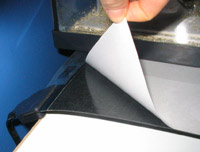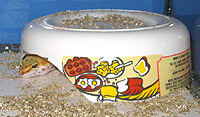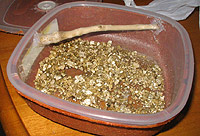The
aquarium
 A 10 gallons tank is a good size habitat for a
lonely gecko. For 2 or 3 geckos, 20 gallons is necessary. Never house
two males together or they will fight to protect their territory.
You'll have to place a mesh or wires lid on the top of the tank even
if this gecko species can't climb vertical walls. Unless you have a
very high tank and that the length between the highest object and the
side of the tank is longer then the total length of the gecko, you can
leave the tank open. The gecko can use his tail to reach higher
places. He usually won't jump when adult.
A 10 gallons tank is a good size habitat for a
lonely gecko. For 2 or 3 geckos, 20 gallons is necessary. Never house
two males together or they will fight to protect their territory.
You'll have to place a mesh or wires lid on the top of the tank even
if this gecko species can't climb vertical walls. Unless you have a
very high tank and that the length between the highest object and the
side of the tank is longer then the total length of the gecko, you can
leave the tank open. The gecko can use his tail to reach higher
places. He usually won't jump when adult.
Cool
and warm area and heat sources
Just like all the other reptiles, lizards need a
heat source to properly digest their food. This is a crucial thing to
consider for the survival of your gecko. This gecko obtain its eat from
the ground and not from a lamp like turtles or tree lizards. A heat pad
is necessary. Never use heating rocks, as they are known to burn lizards
by creating hot spots on the rock.
Heat
pads
 Heat pads and in fact a thin piece of plastic
sheet containing a small heating element. This plastic sheet has a
self-adhesive side that you stick under the tank. This will produce a
warm and constant heat for your gecko. Place the pad at one end of the
tank, in the hot spot, under the lamp. To make it easier, don't remove
the plastic of the self-adhesive part. Just place it under the tank,
this way, moving the tank will be easier and if you buy a larger tank,
you won't have to remove it, which can be pretty complicated most of the
time!
Heat pads and in fact a thin piece of plastic
sheet containing a small heating element. This plastic sheet has a
self-adhesive side that you stick under the tank. This will produce a
warm and constant heat for your gecko. Place the pad at one end of the
tank, in the hot spot, under the lamp. To make it easier, don't remove
the plastic of the self-adhesive part. Just place it under the tank,
this way, moving the tank will be easier and if you buy a larger tank,
you won't have to remove it, which can be pretty complicated most of the
time!
Light
 The light should be an incandescent bulb. The
watts will vary following the size and height of your aquarium. Make
some try and error until the good temperature is reached.
The light should be an incandescent bulb. The
watts will vary following the size and height of your aquarium. Make
some try and error until the good temperature is reached.
In the day, there must be a warm spot ranging from 32 to 35°c
(90° to 95 °F) and a cool zone at 25°c (77°F) At night, the warm
zone will be at 22°c (72°F) and the cool zone at 20°c (68°F)
The idea is to have at least one hiding place in those two
zone so that the gecko can choose where he wants to go. I Usually use 3
hiding place in my big tanks. If he feel a little cold, he can go the
warm zone at night and he the temperature is too hot in the day, he can
go in the cold spot.
The
Hiding spots
 The idea is to create a place where he can be
away from light and sight to sleep in the day. Those spots can be made
of a simple plastic dish in which a hole is cuted. If you prefer, you
can go at the petstore and find some nice rocks imitations.
The idea is to create a place where he can be
away from light and sight to sleep in the day. Those spots can be made
of a simple plastic dish in which a hole is cuted. If you prefer, you
can go at the petstore and find some nice rocks imitations.
 There must be at least one hiding spot per
temperature zone. The more hiding place there is, lesser the stress is
in your gecko, as he can choose where he wants to be and what suite him
best.
There must be at least one hiding spot per
temperature zone. The more hiding place there is, lesser the stress is
in your gecko, as he can choose where he wants to be and what suite him
best.
Humid
hiding spot
When I owned my first geckos, I thought that this
humid box was a very complicated thing. But in the end, this
is very simple! This hiding box will only be used for the
shedding periods of the gecko. To know when it's time to place the box
in the habitat, your gecko will become white. It's important not to
leave the humid box in the habitat for a long period as the gecko can
have skin problems if he is kept in a humid environment. Once the
shedding is done, you can remove the box.
But in the end, this
is very simple! This hiding box will only be used for the
shedding periods of the gecko. To know when it's time to place the box
in the habitat, your gecko will become white. It's important not to
leave the humid box in the habitat for a long period as the gecko can
have skin problems if he is kept in a humid environment. Once the
shedding is done, you can remove the box.
 This humid box is in fact a plastic box with a
hole carved in it, with a damp absorbent substrate at the bottom
light. You can use various kind of plastic container in which you cut
a hole on the top or on the side. To help your gecko with his shedding
process, you can place a small wood stick in the box so that he can
rub against it. I glued mine with melting glue.
This humid box is in fact a plastic box with a
hole carved in it, with a damp absorbent substrate at the bottom
light. You can use various kind of plastic container in which you cut
a hole on the top or on the side. To help your gecko with his shedding
process, you can place a small wood stick in the box so that he can
rub against it. I glued mine with melting glue.
Substrates:
-Vermiculite
-Kitchen
roll paper
-Peat
moss
Water
dish
Even if those are desert lizards, they do need
water. A small water dish should be place in the habitat preferably in
the cold zone to avoid evaporation. You can fill the water dish every 3
or 4 days leaving it to dry between fillings. This will prevent bacteria
and algae from growing in the dish. The main problem you'll have with
the water dish is that the crickets always have the bad idea of drowning
in it! You'll need to provide them a lifesaver material as wire mesh or
some small rocks in the dish to allow them to come out.
In the moment, I'm testing the use of water
bottle usually made for small pets. Those bottles are made of glass and
don't have metal ball in it. I told myself those geckos will surly smell
the humidity and come to lick the glass tube where the water is. For the
moment, I'm testing this in my 3 gecko tanks and for now, no one have
problems shedding and the water level goes down slowly... to be
continued!

 A 10 gallons tank is a good size habitat for a
lonely gecko. For 2 or 3 geckos, 20 gallons is necessary. Never house
two males together or they will fight to protect their territory.
You'll have to place a mesh or wires lid on the top of the tank even
if this gecko species can't climb vertical walls. Unless you have a
very high tank and that the length between the highest object and the
side of the tank is longer then the total length of the gecko, you can
leave the tank open. The gecko can use his tail to reach higher
places.
A 10 gallons tank is a good size habitat for a
lonely gecko. For 2 or 3 geckos, 20 gallons is necessary. Never house
two males together or they will fight to protect their territory.
You'll have to place a mesh or wires lid on the top of the tank even
if this gecko species can't climb vertical walls. Unless you have a
very high tank and that the length between the highest object and the
side of the tank is longer then the total length of the gecko, you can
leave the tank open. The gecko can use his tail to reach higher
places.



